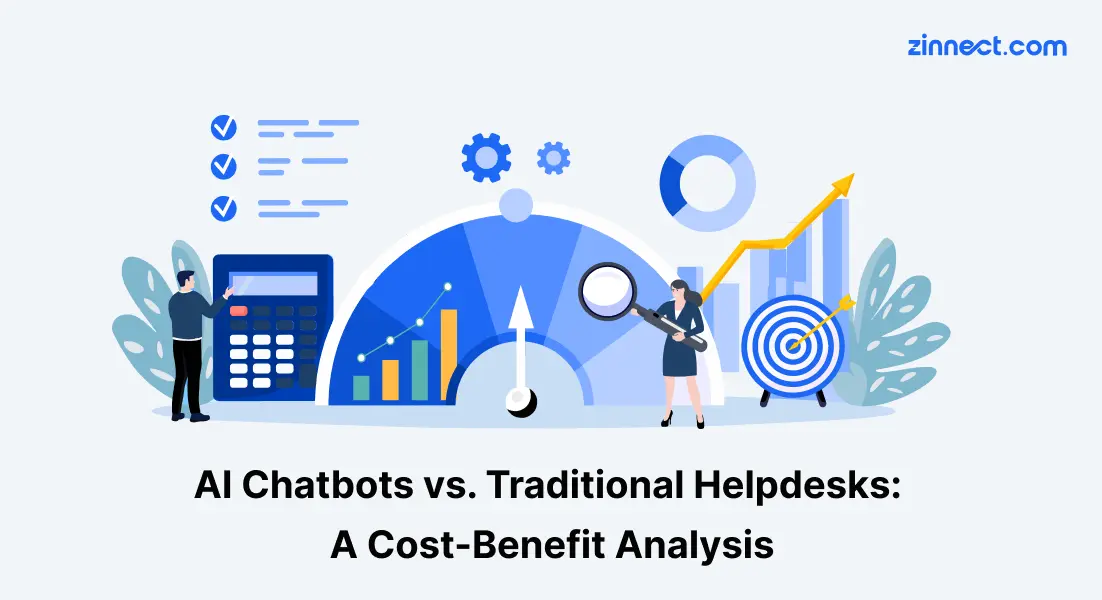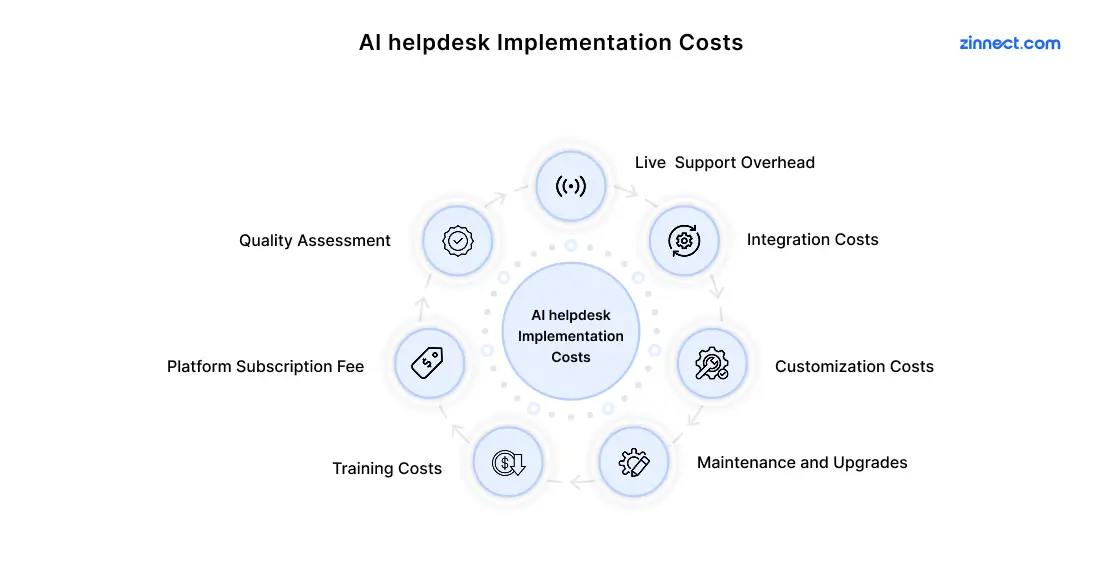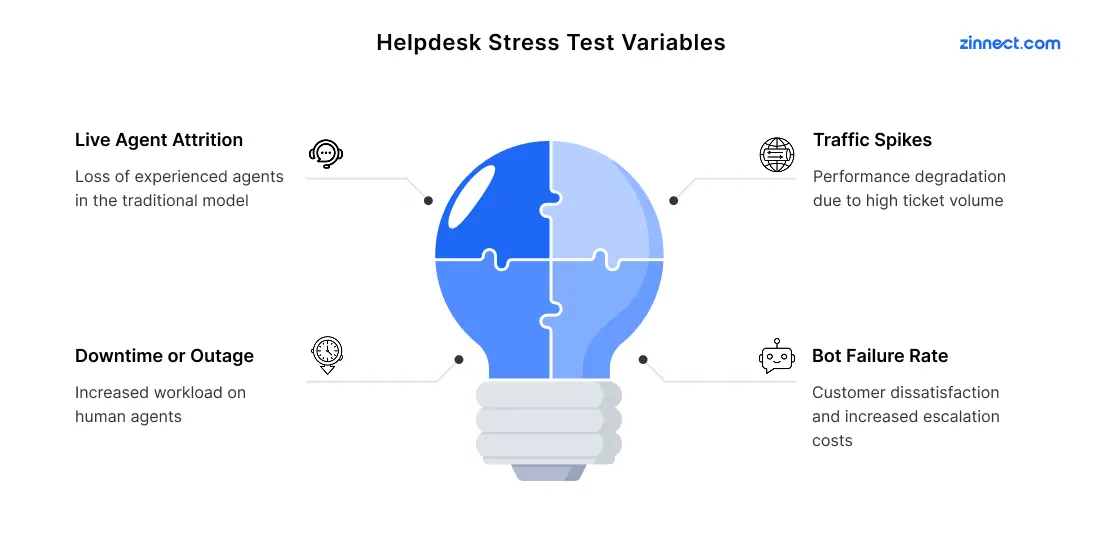AI Chatbots vs. Traditional Helpdesks: A Cost-Benefit Analysis

AI-powered helpdesks offer numerous advantages for businesses. They ensure 24/7 availability of customer support, instant responses, and reduced support costs. However, they are not necessarily the best choice for every business.
While implementing an AI helpdesk can transform small businesses and enable them to compete with bigger enterprises in terms of customer support quality and customer satisfaction, the cost of implementation and operating expenses can sometimes outweigh the benefits, especially if not aligned with your industry, scale, complexity, and customer base.
So, how can you determine the value an AI helpdesk offers to your business? How can you decide whether you need an AI helpdesk or a traditional one with human agents?
This is where cost-benefit analysis comes in. It helps you understand which solution is right for you, not just technologically, but also financially
What Is Cost-Benefit Analysis?
Before making a significant investment to upgrade your infrastructure, operations, or capabilities, it is vital to assess whether the investment will yield benefits that justify the investment. You can determine that with cost-benefit analysis.
Cost-benefit analysis (CBA) is a strategic evaluation method that compares the costs of an investment with the expected benefits. Cost-benefit analysis is not just about monetary gains; it also considers qualitative outcomes, such as customer experience and brand perception.
Cost-Benefit Analysis for AI Helpdesks
A cost-benefit analysis for an AI helpdesk involves calculating the total cost of implementing and operating it continuously alongside human support teams, and comparing it with the value it generates in terms of savings, customer satisfaction, efficiency, and scalability.
Why Do You Need a Cost-Benefit Analysis for AI Helpdesks?
In today’s business landscape, efficiency and cost-effectiveness are the primary areas of focus for businesses. With the advent of the AI revolution, an AI helpdesk seems like a no-brainer.
However, implementing an AI helpdesk may have hidden costs. Though it can bring numerous benefits, it may not give you the return on investment that you expect. This is because businesses often underestimate the real cost of AI, and integrating an AI helpdesk may not necessarily be straightforward.
For instance,
- It may require you to upgrade legacy systems concerning customer support, such as CRM software.
- Transitioning from a traditional helpdesk completely changes how you handle customer support. It may require extensive training of your teams to operate the upgraded business systems.
- You may need to restructure your teams to adjust to the reduced workload on human agents,
- You may need to train some AI systems and continually update and refine them to maintain conversational accuracy and relevance in response to changing trends and customer preferences.
Without taking all these factors into account to calculate the real cost of implementing an AI helpdesk and comparing it with the benefits it returns, it could turn into a misstep. So, So, a chatbot cost analysis is essential. Conducting a cost-benefit analysis helps you determine whether:
- Implementing an AI helpdesk implies overspending on advanced technology, and whether human agents are sufficient for your use case.
- The AI helpdesk comes with hidden costs, such as custom NLP training or data compliance.
- You can justify your investment in the AI helpdesk to stakeholders; a thorough cost-benefit analysis gives you the numbers to back your case.
- The upgrade meets your scaling requirements: AI may be cheaper at scale, but costlier in low-volume scenarios.
Key Metrics You Should Use to Calculate AI Helpdesk ROI
Measuring the following parameters and comparing them enables you to calculate the return on investment for AI vs traditional helpdesks.
| Metric | AI Helpdesk | Traditional Helpdesk |
|---|---|---|
| Cost per Interaction | Low (post-setup) | High (includes wages, training, benefits) |
| Average Handling Time (AHT) | Instant to low | Moderate to high |
| Customer Satisfaction (CSAT) | Depends on bot quality and training | Usually high for complex queries |
| First Contact Resolution | Good for simple issues and frequently asked queries | Better for nuanced cases requiring human empathy and creative problem solving |
| Availability | 24/7 | Limited by shift scheduling/availability of human agents at any given time |
| Scalability | Easily scalable | Requires recruitment and training of more agents |
Step-by-Step Guide to Doing a Cost-Benefit Analysis
1. Define Scope and Objectives
You can fathom the benefits of an AI helpdesk only when you can clarify why you are integrating it into your customer support in the first place.
For instance, if you have plans to scale your operations, your objective might be AI support scalability: to expand your customer support to cover a lot more customers in the future than you currently have. In that case, automating responses and reducing the need for recruiting new human agents would be the priority.
Defining your objectives and priorities helps improve the accuracy of your cost-benefit analysis.
2. User Segmentation & Use Case Mapping
Depending on the nature of your business, sector, and industry, as well as your product offerings, the complexity of your customers’ problems and the queries they raise will vary.
For instance, B2B customers will need support with regard to product specifications, bulk pricing, or shipment options, while a B2C customer may be more concerned about their orders, returns, and refunds.
AI can handle some of those queries, while others require complex solutions that only humans can offer. So, categorize use cases for the helpdesk, including FAQs, billing issues, complaints, etc., and determine which queries can be automated cost-effectively and which still require live support, impacting your cost projections. You can forecast the monetary value of each system based on the findings.
3. List All The Costs Involved in Traditional vs AI Helpdesk
AI implementation cost may include:
- Platform subscription fee
- Cost of integration with your existing systems
- Customizing workflows, intents, and user journeys
- Training the AI helpdesk with relevant data
- Quality assessment and performance monitoring
- Live support overhead, including training the staff on how to work alongside AI systems, including escalations, analytics, and hybrid workflows
- Maintenance and upgrades

Traditional support expenses may include:
- Live agent costs, including salaries and benefits
- Training
- Employee turnover
- Cost of operational inefficiencies during spikes in volume
- Infrastructure and software licensing costs
- Scheduling tools
4. Estimate Quantifiable Benefits
Many key metrics used to measure the value offered by traditional and AI helpdesks, such as Average Handling Time, AI Efficiency, Upsell Conversion Rates, Cost Per Conversation, Resolution Times, CSAT, and Automated Conversation Cost, are quantifiable.
By comparing these numbers, you can determine and quantify the advantages each system offers in terms of cost savings, faster resolutions, agent reduction, or increased conversions.
5. Assign Monetary Values to Intangibles
In contrast to the quantitative metrics that have direct numerical values, some benefits of a helpdesk system are qualitative in nature.
For example, when your customers enjoy a positive experience interacting with your helpdesk, it may lead to retention, brand loyalty, repeat purchases, and referrals. While measuring and quantifying these benefits can be difficult, ensuring the accuracy of the cost-benefit analysis requires assigning an estimated monetary value to these intangibles wherever possible.
In this case, you can use the Net Promoter Score (NPS) of a traditional helpdesk, which correlates with retention and customer lifetime value, as a baseline. For comparison, you can obtain industry benchmarks for NPS changes following AI helpdesk implementation to project revenue from satisfied customers and increased loyalty. Using these estimates, you can compare the monetary value of the intangibles.
6. Calculate Net Present Value (NPV)
Since helpdesk systems often provide value over time, especially as your business scales, future financial benefits should be discounted to their present value using Net Present Value (NPV). This ensures your cost-benefit analysis reflects long-term returns in present-day terms.
7. Break-Even Point Calculation
Knowing when your AI helpdesk starts generating value is crucial. You must estimate when an AI helpdesk will break even and start producing net gains compared to a traditional helpdesk.
8. Calculate AI Helpdesk ROI vs Traditional Helpdesk ROI
After listing all these costs and benefits, you must standardize the metrics and use this formula separately for AI vs traditional helpdesks. Return On Investment (ROI) = (Total Benefits – Total Costs) / Total Costs
9. Compare ROI for Both Options
Once you calculate the return on investment for the traditional and AI helpdesk, you can use the historical helpdesk data you have acquired through the years with the traditional helpdesk to compare with the forecasted AI performance to model different scenarios.
Comparing both ROIs side by side, across different volumes, complexities, and scaling scenarios, gives you a clearer picture of which system delivers better long-term value.
10. Stress-Test Your Findings
A cost-benefit analysis of traditional vs helpdesk systems, based solely on estimates and projections without considering any variables, will be inaccurate. A solid cost-benefit analysis should account for variability.
It is indispensable to stress-test your assumptions by running simulations, creating ‘what-if’ models, and validating how each helpdesk performs in different scenarios. In these stress tests, you must introduce variables like:
- Traffic Spikes when daily ticket volume spikes, and there is a possibility of performance degradation
- Bot Failure Rate due to errors or unhandled queries, and the impact on customer satisfaction and escalation costs
- Downtime or Outage of the AI helpdesk, forcing human agents to step in, increasing workload on them
- Live Agent Attrition in the traditional model

These edge-case evaluations provide a safety margin, preventing over-optimistic AI helpdesk ROI calculations.
Make Your Helpdesk A Growth Enabler With Cost-Benefit Analysis
While AI helpdesks can unlock impressive efficiency, the actual value of helpdesk automation benefits depends on your business size, complexity of support, and long-term strategy.
A thoughtful, well-executed cost-benefit analysis ensures that you adopt the right support solution. By grounding your decision in data, you can optimize both cost and customer satisfaction, making your helpdesk a growth enabler, not a cost centre.